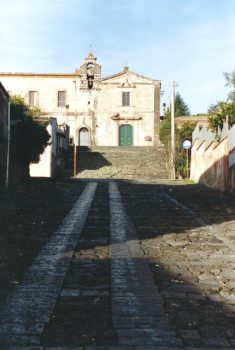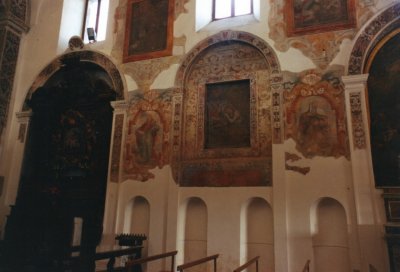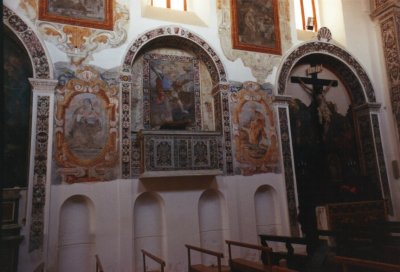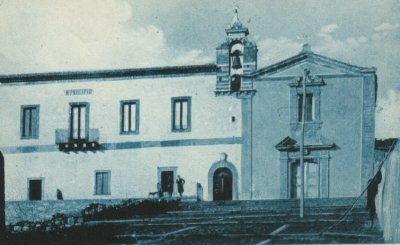Trecastagni
Town ![]()
S. Francesco díAssisiís Convent
| All rights reserved. |
|
No parts of this
publication may be reproduced, stored or transmitted in any form
both for commercial aims and for personal and private ones
|
|
It was founded in 1660 with the money of the believers and for the munificence of the Prince of Trecastagni Scipione II. It is a big building with a cloister surrounded by 21 lithic pillars with a grandiose cistern in the middle. The inside of the portico was painted with the histories of the Franciscan Saints, as it is inferred from the ruins, and it was the work of Giovanni Lo Coco, but today it is completely destroyed because of a whitening. The coat of arms in marble of the Principe of Giovanni is on the Convent door. |
 |
 |
The church with the name of S.Antonio of Padua is composed of an only aisle with frescos of the above-named painter in the vault and on the walls; of great values the altars in carved wood. In a niche hidden by a picture there is a statue in wood, of the Virgin, that it reveals itself on the occasion of the feast. It dates back to 1700 and it is probably of the same unknown that carved the statues of the Misericordia in the Church of the Bianco, of S. Maria of the Graces in that of S. Alfio, of S. Giuseppe and S. Nicola from Bari in the Mother Church. Two bells are in the belfry: the small dedicated to the Immaculate Virgo was made in July in 1755; the biggest, work of the smelters Giuseppe and Salvatore di Mauro father and child, was fused in 1851 at the believersí expense and dedicated to S.Antonio of Padua. |
|
In the sacristy to which you can have access from a small door, precious sacred hangings. The organ, precious construction of the time, is no more in conditions of work, and any vital pieces have been removed. The outside of the convent presented a polychromy of white and black, the black obtained from the lava and the white from freestone. The portal of the church had remade after the 1693 earthquake, using the old lava material with characteristic lines and completing it with freestone, it is surmounted from a window in baroque style, and on the top from a princely coat of arms with the symbols of the passion. On the pediment of the door the following inscription is read, broken up by the coat of arms of the Franciscan Order: IUNCIMUS HOSPITIO DEXTRAS 1700 |
 |
|
On the right of the church there is the ancient Cemetery, nd an underground chapel with places for the mummification of the dead bodies. In the apse to the right of the High Altar, monumental sepulchre of precious marbles with the bust of the Prince Domenico III di Giovanni. For the abolition of the convents in 1866, the building went on to the State, and it was defaced with occasional adaptations and used as Town Hall, Magistrateís Court, Office of the Court, Conciliation, prison and as a primary school. While the church served as a deposit, barracks and electoral centre. Also the rich library, entrusted to the Town Hall was neglected, and today it is not known if and how much was preserved for the admiration of the descendants. |
 |
| (N.d.R.) After the last works of restoration, it is possible to visit the rooms used for the embalming of the dead bodies and for the collection of the mummified bodies. (See analogous practice at Savoca (Me) and in the Convent of the Cappucini Monks in Palermo) |  |
